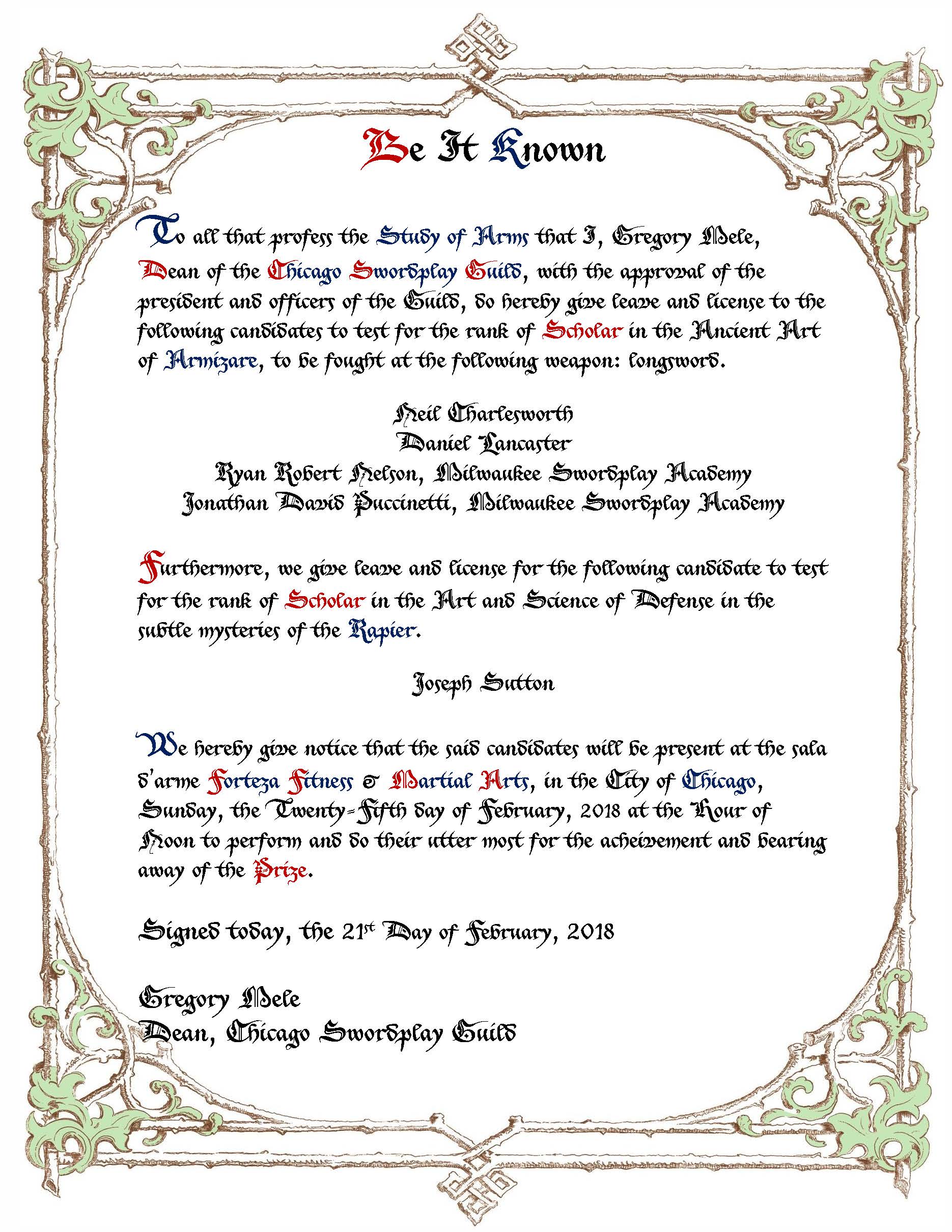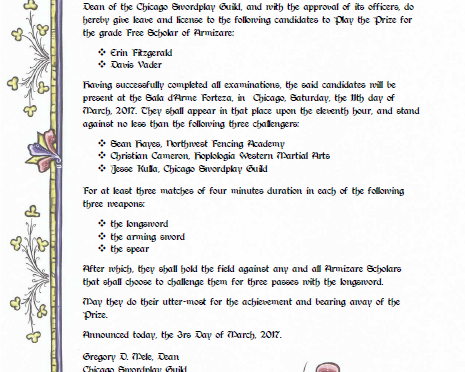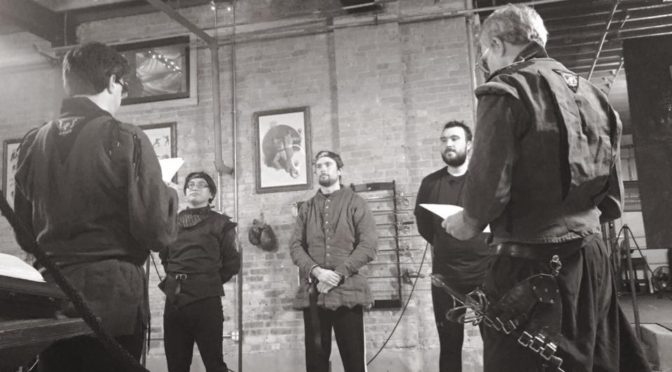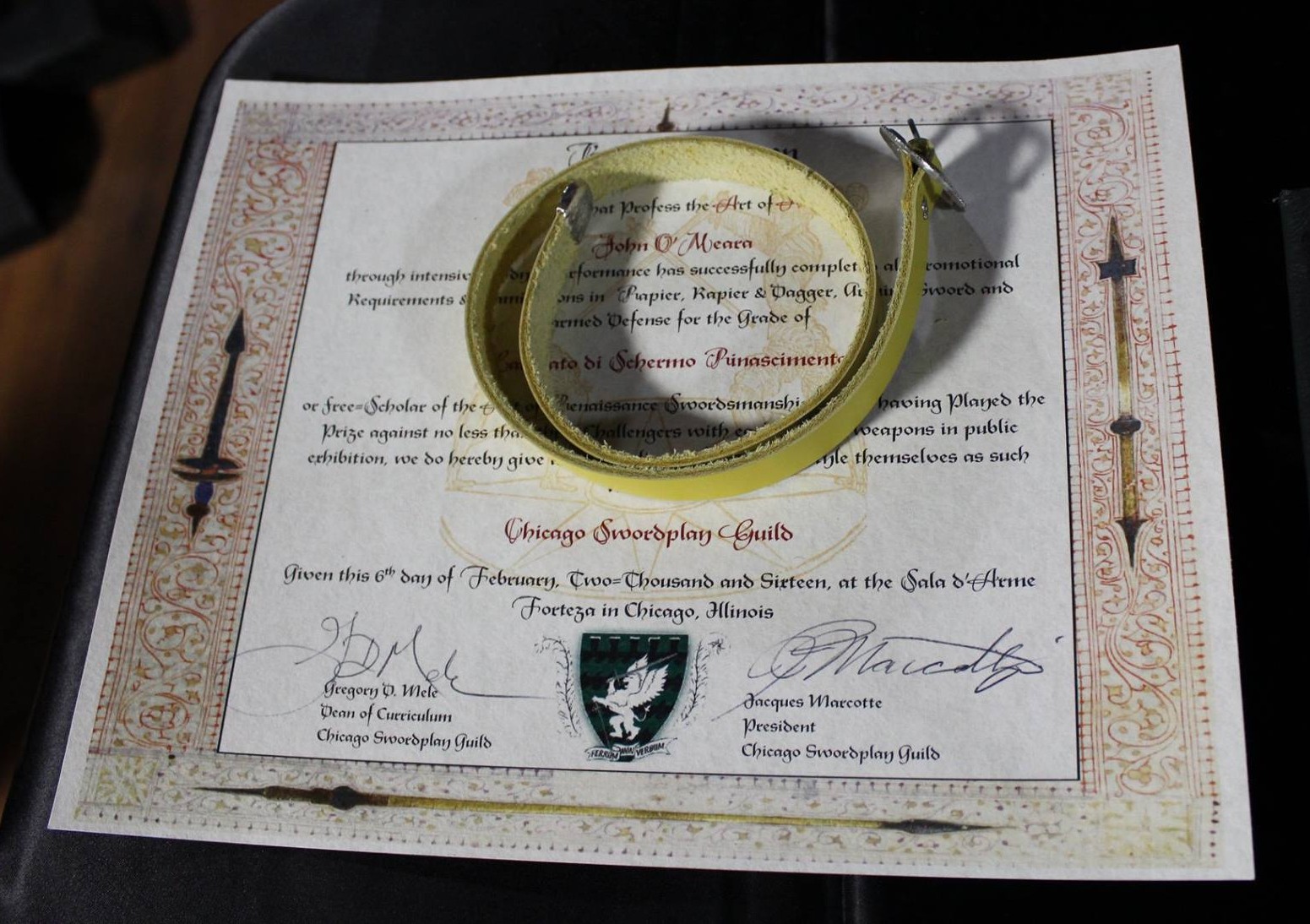Tag Archives: Prize Play
We Have Two New Armizare Free Scholars!
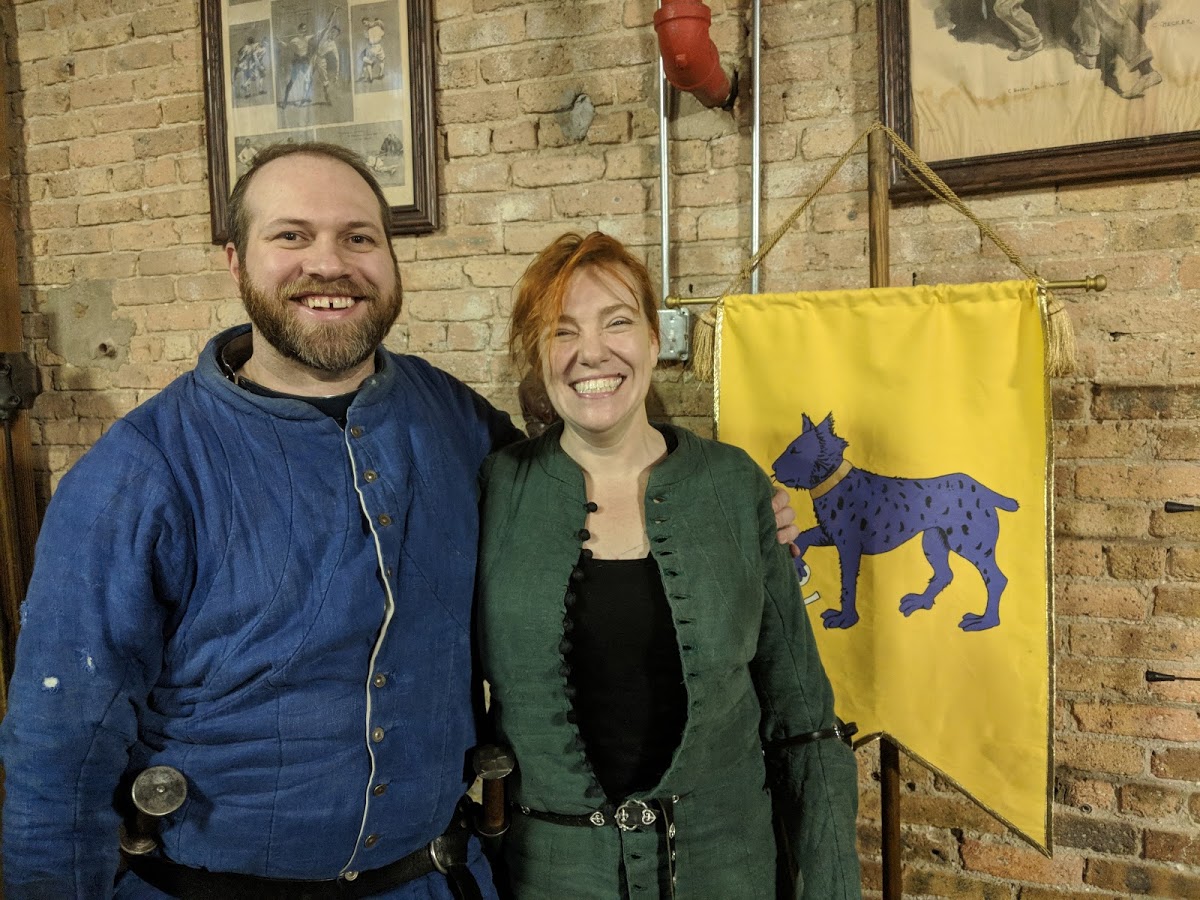
Neither rain, nor sleet, nor snow (lots and lots and lots of snow) could stop this past weekend’s Free Scholar Prize Play!
As discussed elsewhere, the Guild uses a ranking system traceable to the fencing schools of the late 15th and 16th centuries. In the English tradition the grade of free scholar denoted a senior student who had grasped enough of the basics to move on to more advanced training. An analogy can be found in the modern academic system, with a scholar being equivalent to an undergraduate, and a free scholar similar to a graduate student. (Those familiar with modern Asian arts might it similar to a 1st degree black-belt: a recognition of embodying the fundamentals of the art, being able to apply it across the system, and therefore having the tools to take a truly deep dive onto the path to mastery.)
Nicole Allen and Jacques Marcotte are two long-time Guild members. Nicole joined the CSG only a few months after its founding in January 1999, played her Armizare Scholar’s Prize in 2001 and is part of the first group of students to become double scholars (Armizare and Renaissance Swordplay). Jacques joined several years later, and has been an assistant instructor for many years, teaching the Saturday morning Taste of the Knightly Arts class since time immemorial (or 2009). Consequently, they are vibrant, integral parts of the CSG family, and this made their at testing for Free Scholar all the more a cause of celebration.
PREPARATION, or, IT’S MORE THAN JUST FIGHTING
By Guild custom, students must spend at least three years at the Scholar rank before progressing to Free Scholar, although in practice it has taken twice that time or longer. In part, this is because, prior to opening of Forteza Fitness, and with it, the implementation of multiple training days, it was impossible for students to get in enough training time “on the mat”. Additionally, the Scholar curriculum is extensive, comprised of the entirety of Fiore dei Liberi’s dagger curriculum for use out of armour, longsword at wide play, elements of longsword and close play, arming sword and spear. Each of these components has its own written, skills and sparring exams, and students must pass all of them, a number of reading assignments, and complete a scholar project before being allowed to take their comprehensive written and skills exams.
Nicole’s project involves an annotated copy of the Getty Manuscript, designed to show visual interconnectedness of the sword and dagger, interwoven with student’s training notes. Whereas her project involves assisting the student, Jacques turned his attention to the teacher, creating a teaching guide of tips, traps and suggestions for new instructors teaching the introductory longsword course, as a companion to the curriculum outline. (Both projects are in final revision, after which they will be made available to Guild members.)
THE PRIZE, or, NOW WE FIGHT!
One of the most important steps in the progression from the grade of scholar to master is the concept of prize playing. Having passed all internal examinations, the student to submit a challenge for a public prize playing (free fencing exhibition), for the grade being tested for. The Prize is fought in two parts:
- Three, four-minute rounds with each of three weapons: longsword, arming sword and spear.
- The Ordeal, in which the prizor holds the field against all Guild Scholars who wish to challenge them to three blows with the sword.
At the CSG we have always invited one or more outside challengers to help test the prizors’ skill at arms. This past weekend, we were joined by Mr James Reilly, chief instructor of the Wisconsin Historical Fencing Association’s Kenosha branch, and Mr. Christian Cameron of Hoplologia in Toronto, Ontario. Joining CSG Free Scholars Davis Vader and Erin Fitzgerald, together they provided the timed rounds of the Prize.
We are still processing and uploading video, but we have pulled a few sample fights to share right away:
Spear: Nicole vs. Erin
Spear: Jacques vs. Davis
Spear: Nicole vs. James
Sword in One Hand: Jacques and Davis
Longsword: Jacques and James
Longsword: Nicole and Erin
Longsword: Jacques and Christian
SWEARING THE OATH
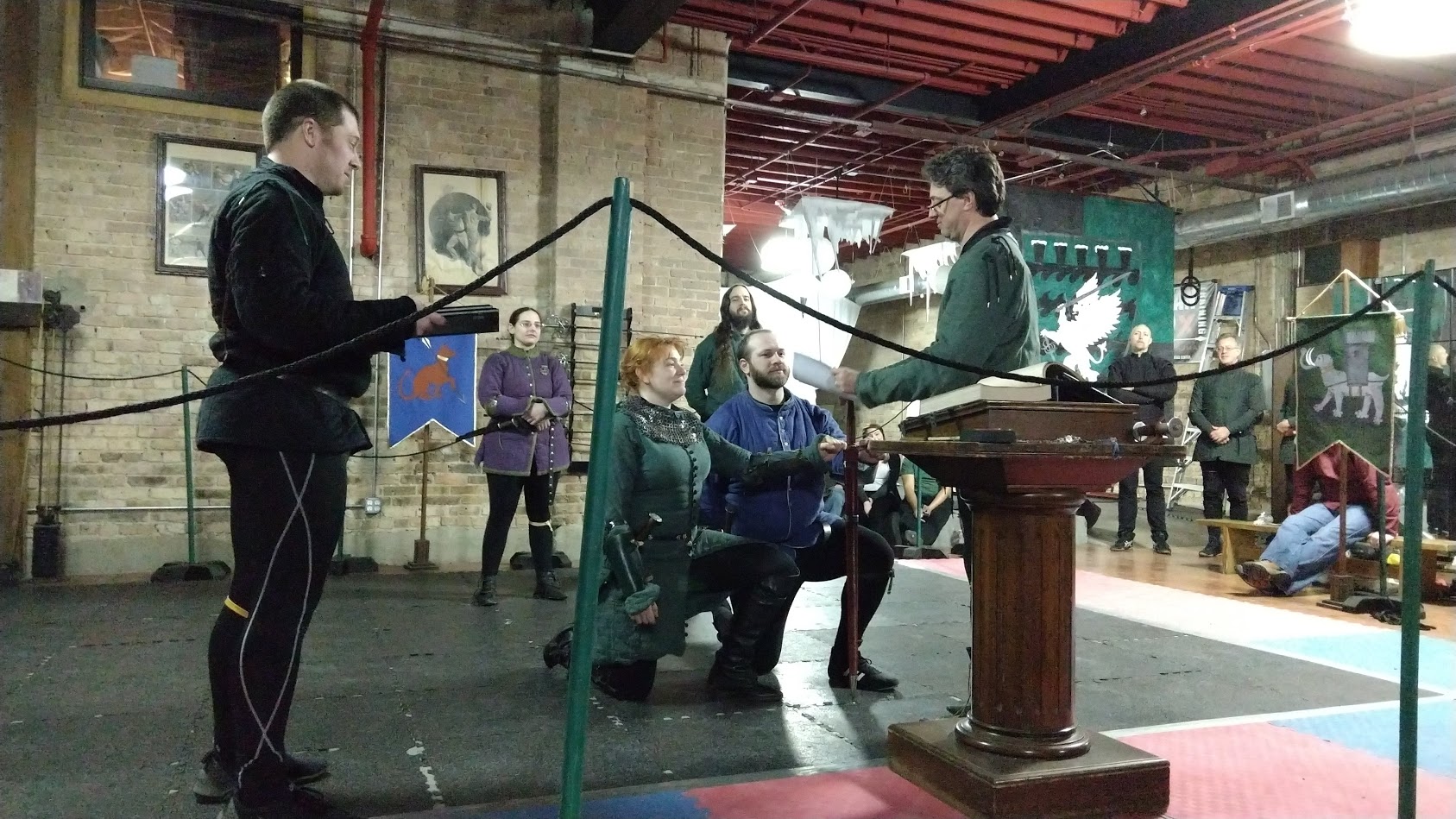
Ceremony and ritual was a large part of medieval and Renaissance life, and although our Guild is a modern one, we seek to connect to the spirit of those who have gone before through both the Prize and the ceremony by which our Scholars, Free Scholars and Provost are invested in their rank. The investiture ceremony involves a lesson on the symbolism of Fiore’s four animals, a charge with new responsibilities and duties, the bestowing of gold garters, and finally, a swearing of the Free Scholar’s Oath, adapted for modern use from those of the old London Company of Maisters.
Much of the modern world has lost the sense of ritual and its purpose: to initiate. At its heart, the Prize is an ordeal: both in preparing for the exams, and then facing your peers (or those whom you wished to be acknowledged as a peer) and your fears in front of friends and loved ones. It’s an ordeal that also brings student and teacher, prizor and challenger, together in a unique bond that is revealed to be both ordeal and celebration; a symbolic reflection of how we travel the road to mastery of both the art and ourselves alone, yet succeed through the presence and support of our community.
Speaking of that community we are all extremely proud of Jacques and Nicole both for the hard work training, testing and fighting, but also for the long years of service and support they have shown their Guild family, marrying the chivalric virtue of prowess with that of largesse. A hearty and heart-felt congratulations to them both!
Announcing a Play of the Prize for the Grades of Provost and Free-Scholar
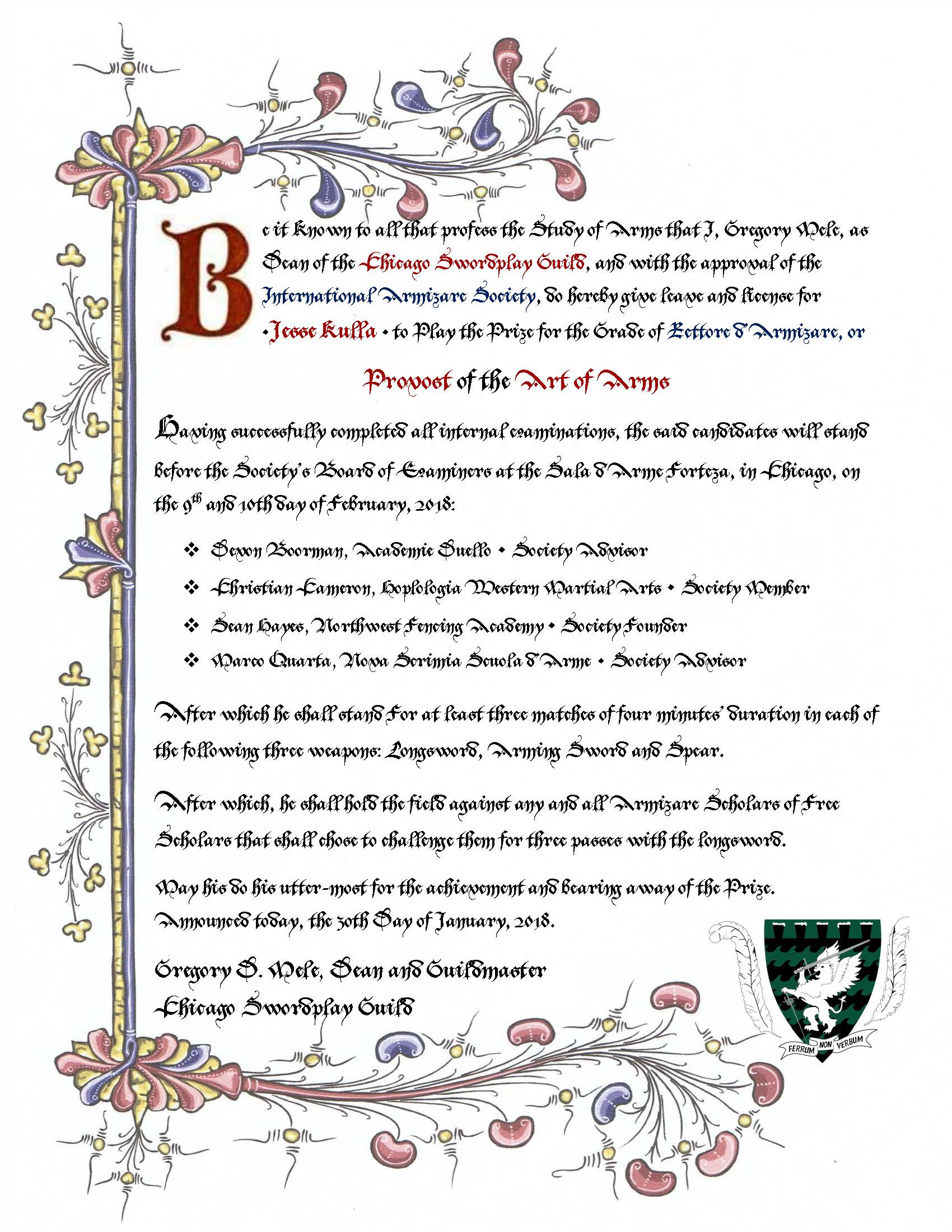 We are pleased to announce there will be a playing of the prize for the grade of Laureato d’Armizare (Free Scholar of the Art of Arms) and Rettore d’Armizare (Provost), this upcoming Saturday (February 10, 2018), at the Sala d’Arme Forteza, in Chicago.
We are pleased to announce there will be a playing of the prize for the grade of Laureato d’Armizare (Free Scholar of the Art of Arms) and Rettore d’Armizare (Provost), this upcoming Saturday (February 10, 2018), at the Sala d’Arme Forteza, in Chicago.
This will mark a huge occasion for the Chicago Swordplay Guild as this will also mark the creation of both our first Armizare Provost, and the first to be created under the auspices and procedures set out by the International Armizare Society. The candidate, Jesse Kulla, has also been with us since virtually the beginning, and over the years has developed quite a reputation in the local, regional and national HEMA community. (We will be posting a full overview of the process, with video from the various examinations and Prize, in the next week or so.)
In addition, the day marks our third Armizare Free Scholar Prize since the Guild’s inception, the candidates are long-time Guilders. Nicole Allen of Revival Clothing and Historica fame, has been with the Guild since shortly after its founding in 1999, and Jacques Marcotte has been one of our Taster Class instructors for nearly a decade.
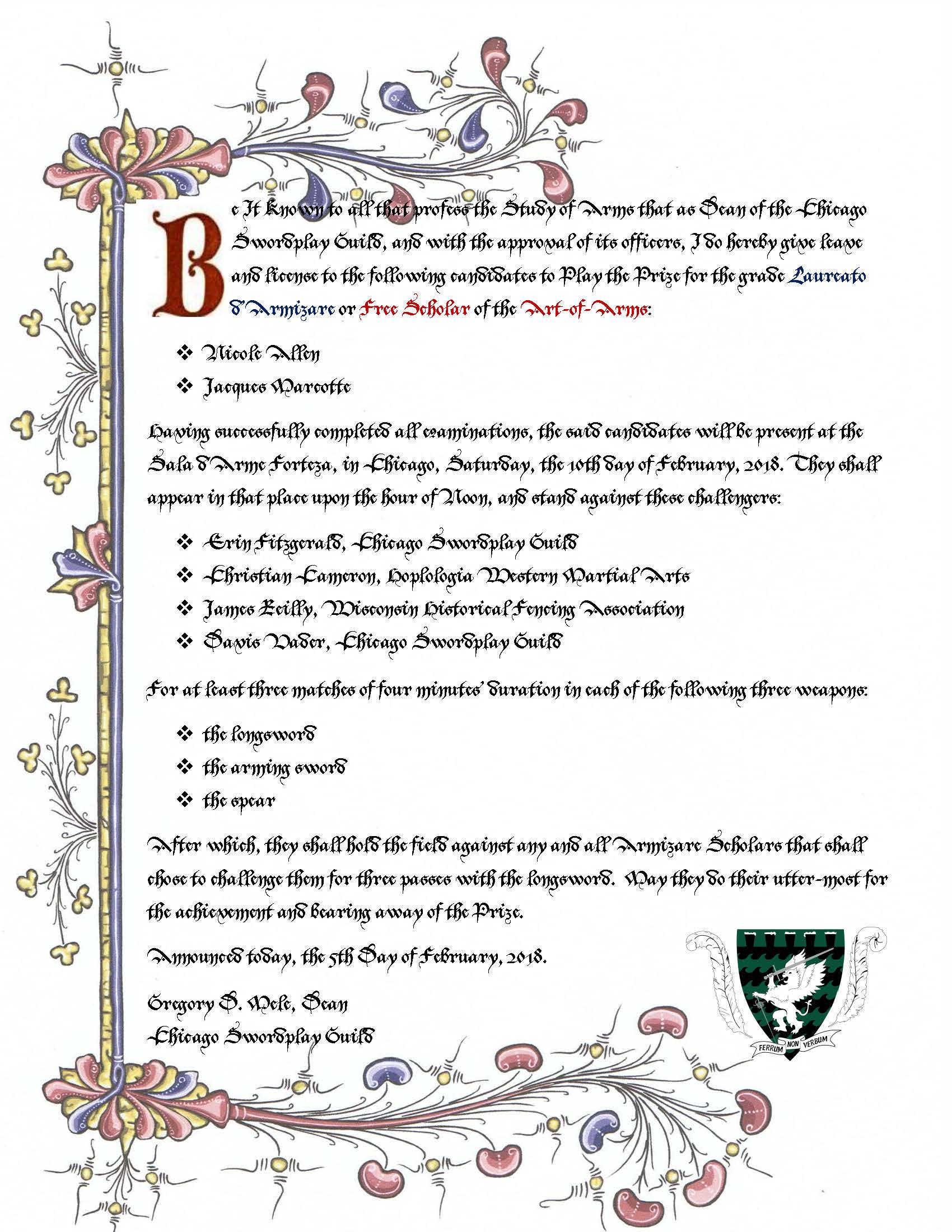
Please join us in wishing Jesse, Nicole and Jacques the best of luck in the upcoming ordeal!
Armizare Free Scholar Prize Announcement — March 11, 2017
We are pleased to announce there will be a playing of the prize for the grade of Laureato d’Armizare (Free Scholar of the Art of Arms), this upcoming Saturday, at the Sala d’Arme Forteza, in Chicago.
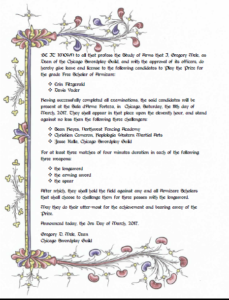
On Playing the Prize
This past weekend, the Guild held a scholar’s prize in both longsword and rapier. We are pleased to admit Andrew White, Vlad Hintaut and Robert Salud as new Scholars. You can see their bouts here.
(Video courtesy of Evan Laney)
A right of passage in the Guild, we are often asked what a Prize is and how it works. Free Scholar, Jesse Kulla provides a great, insider’s look at how the CSG uses Prize-Playing.
http://redwolfswordsmanship.blogspot.com/2016/10/playing-prize-leveling-up-at-chicago.html
Our First Renaissance Free Scholar and first-ever Provost!
This past Saturday saw a momentous occasion for the Chicago Swordplay Guild: our second Free Scholar’s Prize and our first-ever in Renaissance Swordsmanship. The Prize is not a play, a tournament or an exam, though it has elements of them all. It is a right of passage whose origins extend back over half a millennia, and is the most ceremonial event we have in the Guild, as well as the most personally meaningful to the student being tested.
[For more information on Prizes as they were historically and used in the CSG, see What is a “Playing of the Prize”?
To qualify to play the prize for Free Scholar, students have completed at least five to seven years training in the weapons for the curriculum being tested; in this case the Bolognese side sword, the rapier, rapier & dagger, wrestling (abrazare) and unarmed defense against the dagger. Physical exams in these disciplines amounted to about four hours of testing, and there was also a written exam for each. Additionally, each student is required to submit a written, research paper; here is Robert Rotherfoord’s paper on the Universal Parry and Great Blow in Bolognese fencing. Once the exams have been passed and the final paper accepted, then the Prize can be held.
Going back to our first Prize in 2001, it has been the CSG’s tradition to never inaugurate a new rank without bringing in outside teachers and swordsmen to stand as challengers, specifically to avoid nepotism and developing a salle art rather than a truly martial one where students learn how to defeat students in their school, and their school alone. As Dean, I felt it crucial I find three of the best Renaissance swordsmen in North America to stand as Challengers, and fortunately, my first choices all said yes. Thus, John and Rob found themselves standing across the list from:
- Devon Boorman, Maestro d’Arme, Academie Duello;
- Puck Curtis, Maestro d’Arme, Sacramento Sword School;
- Bill Grandy, Head Coach of Historical Fencing, Virginia Academy of Fencing.
All of these men are long-time practitioners and teachers of the Art of Defense; Devon and Bill run two of the largest HEMA programs in the world. In addition, while Devon practices the same arts we do in the CSG, the other Challengers brought surprises of their own to the table. Bill Grandy is also a longtime student of Salvator Fabris’ rapier method, and is familiar with Bolognese side sword, but his cutting-sword focus is in the German messer and longsword. Puck is one of the world’s premier exponents of La Verdadera Destreza, a system that rivaled the Italian tradition and uses a different set of strategies and tactics to achieve the same goal: pointy end into the other man. I had made these choices by design, as the idea was to make the Prizors not only display their ability to fight a like style, but to use their art against a foreign one.
The format of the Prize is similar to that played for Scholar, only with three weapons: each Prizor faces three Challengers in a three minute round of combat, for nine rounds of combat in total. They then hold the field in matches of three good blows against all Scholars who wish to challenge with either the sidesword or rapier. Challenges at are fought under a set of rules somewhat more “permissive” than those of the 16th century, in large part because of access to additional safety gear:
- The entire body is a target;
- Strikes may be made with the point, edge or pommel of the sword;
- Disarms, grapples, leg sweeps and throws are permitted, but combat will stop once both parties are unarmed, or one is thrown to the ground.
- Combatants acknowledge their own blows, and the Judge intervenes only to part combatants with his baton for safety reasons or because a throw or disarm has occurred.
The First Passage: Side Sword
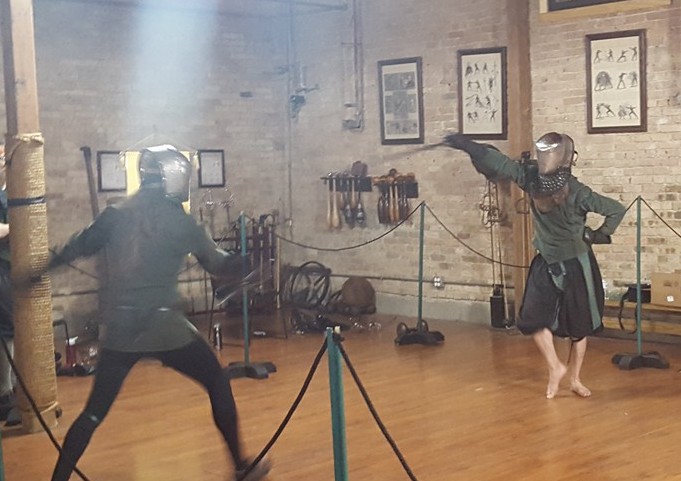
The candidates had asked to fight the weapons in chronological order: sword, rapier & dagger and then rapier alone. It was determined that the order of challenges would be Puck third, Devon second and the honor of the first blow would go to Bill. Well before their arrival in Chicago, I had been in contact with the Challengers and discussed John and Rob’s particular fencing quirks, strengths and weaknesses, so each was not only going into the list to fight them, but to test specific things, most particularly, their weak points.
The first round was dedicated to the sword alone, which is Robert Rotherfoord specialty. As you watch the fights you will see that he and John use the art somewhat differently: as a rapier specialist, John gravitates towards the later style advocated by Angelo Viggiani, including the powerful use of a rising parry transforming into the punta sopramano/imbroccata (overhand thrust) made on a short lunge, or the use of the same thrust as a provocation to set-up follow on actions.
John O’Meara vs. Bill Grandy
John O’Meara vs. Devon Boorman
John O’Meara vs. Puck CurtisRob, who favors Manciolino and Dall’Aggochie, uses shorter thrusts and more cuts made with steps off-line.
Robert Rotherfoord vs. Bill Grandy
Robert Rotherfoord vs. Devon Boorman
Robert Rotherfoord vs. Puck Curtis
The fights were vigorous and also great fun to watch; the audience loved the dynamic elegance of the Bolognese system’s flowing, looping cuts and powerful thrusts.
The Second Passage: Rapier & Dagger
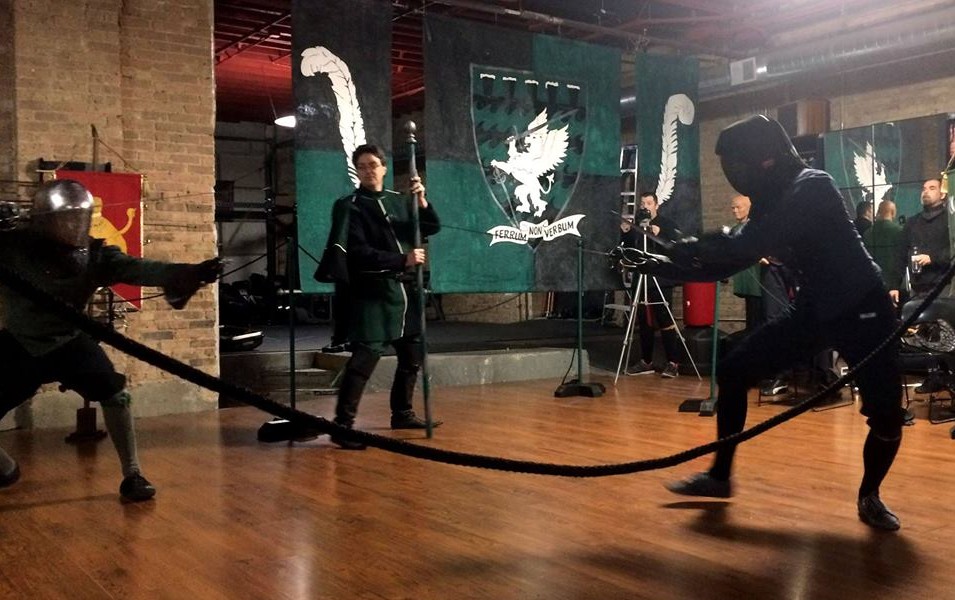
The second round was with the rapier & dagger, the newest part of the Renaissance scholar curriculum, and a very demanding one, as it requires constant changes of initiative while wielding two dissimilar weapons both in conjunction and separately. It can be very fast and exciting to watch, and as I personally had not seen Destreza’s version of the system, it was personally interesting to watch how it played against the “Salvatoran Art”.
John O’Meara vs. Bill Grandy
John O’Meara vs. Devon Boorman
John O’Meara vs. Puck Curtis
Rob Rotherfoord vs. Bill Grandy
Rob Rotherfoord vs. Devon Boorman
Rob Rotherfoord vs. Puck Curtis
The Third Passage: Rapier Alone
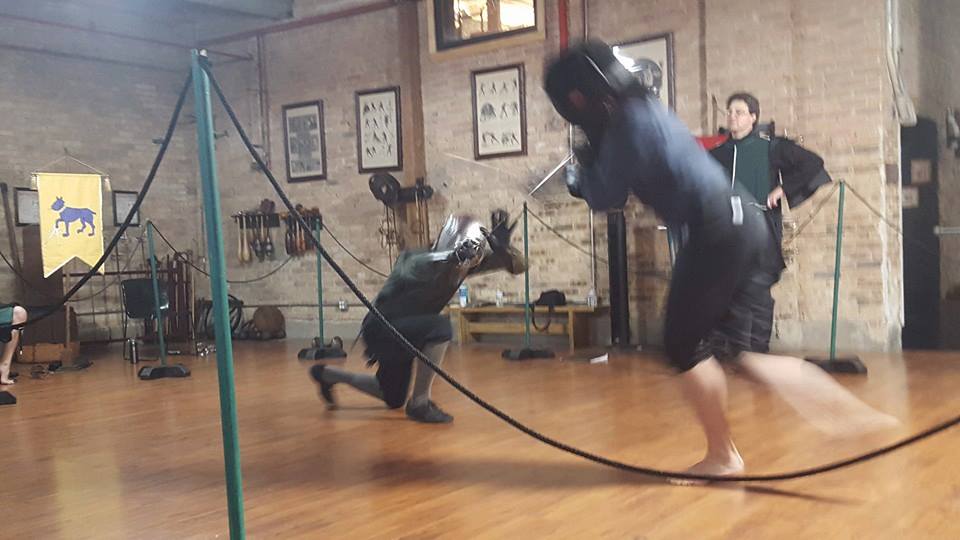
The rapier used alone is the first weapon taught in the Renaissance curriculum and goes back to the very first year of the Guild’s history. It is an easy weapon to understand, but a difficult one to master. Although we draw material from a variety of c.1600 sources, far and way the core of our curriculum comes from the monumental text by Master Salvator Fabris.
However, as the third weapon fought, you can see the fatigue starting to kick in and the Prizors periodically retreat or come to grips just to catch their breaths, rather like “the clinch” in modern boxing.
John O’Meara vs. Bill Grandy
John O’Meara vs. Devon Boorman
John O’Meara vs. Puck Curtis
Robert Rotherfoord vs. Bill Grandy
Robert Rotherfoord vs. Devon Boorman
Robert Rotherfoord vs. Puck Curtis
Final Passage: “The Ordeal”
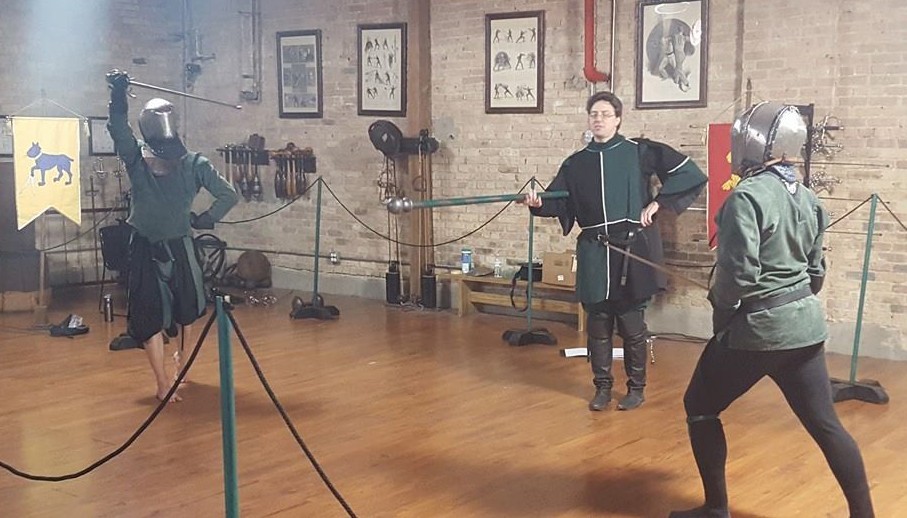
In times past it was the custom that Prizors must fight no less than three Challengers of the grade sought, before the Prize would be considered won, but that he must stand against any and all challengers who might come forth to test him. Likewise, having faced three challenges in each of the three weapons of the Free Scholar, the candidates then stood against any Scholar would would challenge them to a match of three good blows with the rapier or sidesword.
John Runs the Gauntlet
Rob’s Gauntlet
You can see both fatigue and the effect of earlier cuts to the sword arm taking their toll in these bouts, as Rob drops his sword twice because his hand is getting numb.
(You may also hear me asking David Farrell if he is wearing his long underwear. As it turns out, yes, yes he was. Don’t ask.)
The Investiture
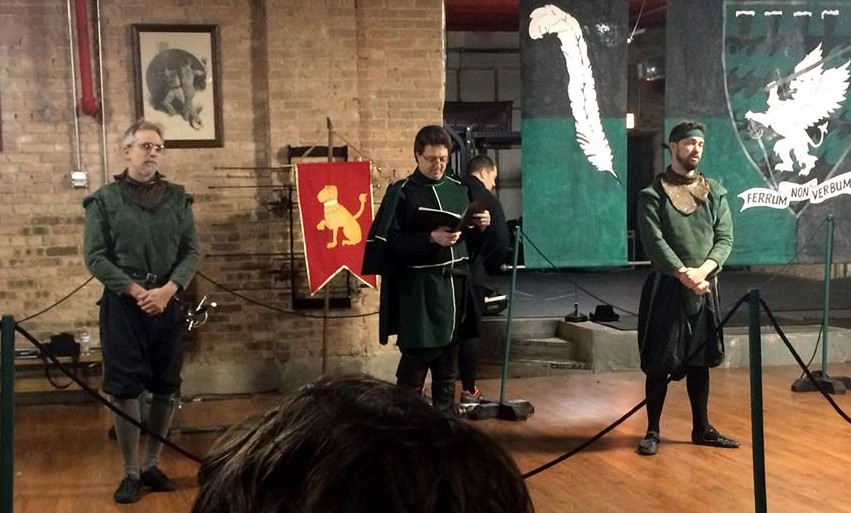
Historically, once all the bouts were over, if the Prizor was judged victorious by the four Masters, he would be declared “a well-tryd and sufficient man with divers weapons”. He would then (after collecting the change littering the stage) swear his oath of obligation, and be escorted by his new peers back to the school and from there off to do much drinking. Fortunately, our guests felt that the John and Rob easily fulfilled the requirements of their new rank, leading to the ceremony of Investiture.
Our modern Guild’s Scholar’s oath is adapted directly from that of the Elizabethan London Company of Masters, requiring the student to treat those above and below him or her with respect, to train diligently and with pride, but not vanity, to be sure that their actions and deeds in the list or the classroom bring renown, not shame, to their fellows and teachers, and to be a good citizen.
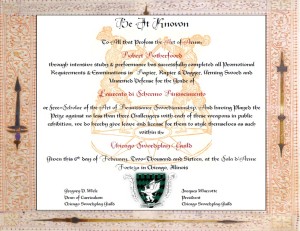
Kneeling and reaffirming this oath on the hilt of a sword, the gentlemen received their new licenses and their green garters were replaced with gold ones. As stated in the ceremony itself:
Gold was considered the noblest of metals, exceeding all others in value, purity and finesse. It represents the light of the sun, and the nobility of princes. It is also associated with excellence and achievement, and its bearer surpasses all others in valor. As such, the golden garter is a fitting symbol of a Free Scholar of the Art of Arms.
As John was Rob’s teacher in rapier and rapier & dagger, it only seemed appropriate they he bestow the garter himself. However, as this would normally be the provenance of a Provost…
We caught John off-guard and informed him that such he was about to be!
This decision was not made lightly by myself or the three Challengers. John joined the Guild in the year of its founding (1999) and has spear-headed the Rapier curriculum since 2002. Over that time, there have been many ups and downs — a steadily evolving curriculum that went through a few reboots, a seeming curse where every time new Scholars were made, life took the away from both the Guild and the Art, significant, side-lining injuries with long recovery time and more. Thus, it is some how particularly appropriate that John received his rank of Provost at a time when our Renaissance swordplay program is larger and more robust than ever before.
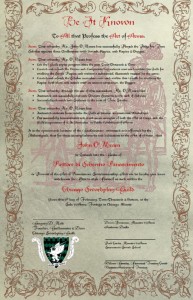
Some of Mr. O’Meara’s accomplishments leading to his award of Provost:
- Led the Guild rapier program since the year Two-Thousand & Two;
- Created and refined the Novice and Companion Curriculums now used within this Guild for wielding the Single Rapier, and written a substantial, illustrated manual for the same;
- Created and refined the Scholar curriculum now used within this Guild for wielding the Rapier, both alone, and paired with its ancient companion, the Dagger;
- Instructed and successfully elevated Thirteen Students to the rank of Scholar;
- Successfully elevated two Students to the rank of Free Scholar;
- Instructed students from outside the Guild at diverse, international Workshops;
Thus, it was my particular honor as the Guild’s founder and Dean to elevate Mr.John O’Meara as the CSG’s first Rettore di Schermo Rinascimento (Provost of the Art of Renaissance Swordsmanship).
Besides the gold garter, as a Provost John was given a ceremonial chain of office; its links representing the long line of teachers who have preceded us. The chain is not whole, just as our lineage was broken long ago, but instead is closed by a pendant of St. George the Dragonslayer, paragon of chivalry, for this is a chivalric art, and it is through its values that what was broken is again made whole. In this sense, the chain becomes a fitting symbol uniting past to present, and present to future.
This was a truly special day — the culmination of a decade and a half of hard work as well as the inauguration of the next phase in the Guild’s history, particularly in the field of Renaissance swordsmanship. My thanks to Maestri Boorman and Curtis and Coach Grandy for attending and helping bestow the Provost rank, and to John and Rob….words cannot express my pride.
Gregory D. Mele
Founder, Dean and Guildmaster
Chicago Swordplay Guild
[You can find a great many more photos of the event both in our Gallery and on the CSG Facebook Page]
Announcing a Playing of the Prize for Free Scholar
A Video Look into a Scholar’s Prize
This past weekend (April 22) the Chicago Swordplay Guild held its first Prize at Forteza Fitness, Physical Culture and Martial Arts.
Although this was the first Prize to be fought at Forteza, Playing the Prize has been part of rank advancement in the Chicago Swordplay Guild since 2001, and we proudly embrace the traditions of our ancestors. Family and friends of the candidates, Guild members past and present, and guests from other martial arts schools, are all invited to attend this public exhibition of arms. Much like the original Prize, ours are a combination of formality and raucous celebration. Refreshments and music entertain the audience before the Prize begins and during breaks between challenges. Rather like watching a tournament, spectators are encouraged to cheer good blows, and to boo wild, uncontrolled blows.
A Brisk Longsword Match Between Erin Fitzgerald and Shannon Winslow
This cheerfully irreverent atmosphere offsets the formality of the Prize itself. The list (cordoned off combat ring) is decorated with heraldic banners representing the Guild and the virtues ascribed to the medieval warrior (if you’ve been paying attention to our website, you already know that these are strength – speed – knowledge and courage!). The Prize begins with a formal opening ceremony, taken from their Renaissance precursor, and then each candidate is called forward one at a time, their challengers are announced, and combat begins.
The fighting is serious, the fighters are not: Trey Ptak challenges Rob Rutherfoord’s right to not only call himself a Scholar, but to bear the title of Mr Fancy Pants. (Don’t worry, the pants have since been burned.)
Armizare students fight their Prize with the longsword, while Renaissance Swordsmanship students fight with the single rapier. Challenges at the Scholar level are fought under a set of rules somewhat more “permissive” than those of the 16th century, in large part because of access to additional safety gear:
- Each match is 3 minutes in length;
- The entire body is a target;
- Strikes may be made with the point, edge or pommel of the sword;
- Disarms, grapples, leg sweeps and throws are permitted, but combat will stop once both parties are unarmed, or one is thrown to the ground.
- Combatants acknowledge their own blows, and the Judge intervenes only to part combatants with his baton for safety reasons or because a throw or disarm has occurred.
As this is not a tournament, but an examination, each Challenger is given a specific task for their match with the Prizor, based on the observations of the instructors. For example, if the candidate has trouble initiating attacks, one Challenger might be told to hang back, forcing the Prizor to pursue and open with attacks. Conversely, a Prizor who starts strong but tends to “stop and look” might find their opponent continuously presses in with an unrelenting barrage of blows.The purpose is to push the Prizor physically and mentally, under the added stress of the watching eyes of friends and family.
One place where we have decidedly improved upon the past is that Guild Prizes are distinctly co-ed. Weapons are a great equalizer in terms of strength and size, and female students face men and women Challengers equally. Guild membership has traditionally been about 1/3 female, but this past Saturday saw three ladies take the field as Prizors, out of six competitors in total!
Shannon Winslow gives Prizor Nate Wisniewski the “What For”, Before Getting Taken for a Ride

Once all the bouts were over, if the Prizor was judged victorious by the four Masters, he would be declared “a well-tryd and sufficient man with divers weapons”. He would then (after collecting the change littering the stage) swear his oath of obligation, and be escorted by his new peers back to the school and from there off to do much drinking. Our modern Guild’s Scholar’s oath is adapted directly from the Elizabethan one, requiring the student to treat those above and below him or her with respect, to train diligently and with pride, but not vanity, to be sure that their actions and deeds in the list or the classroom bring renown, not shame, to their fellows and teachers, and to be a good citizen. Students kneel and swear this oath on the hilt of a sword, receive their license and are gifted with a green garter tied under the left knee – a symbol of their rank. Finally, they sign their names in the Guildbook – a custom-made, leather-bound volume containing the history, rules and doings of the Chicago Swordplay Guild. (One such guildbook is in Ghent, home of the oldest surviving fencing school in the world. While the modern guild is a sport-fencing club, the records and entries in its book go back to its founding in 1614!)

Or course, it would be quite foolish to preserve all of these Renaissance customs without including the celebratory drinking at an inn! And so, with all due diligence, the tired, and bruised newly-minted Scholars were escorted by their colleagues to O’Shuaghnessy’s Public House for a pint or four. Slainte!
Our hearty congratulations go out to Christina, Erin, Heather, Jake, Robert and Nathan and our thanks to Shannon, Dan, Davis, Jacques, John, Phil and Trey for serving as Challengers!
You can find more videos of the Prize on YouTube.

